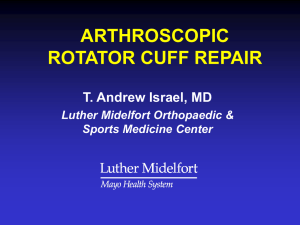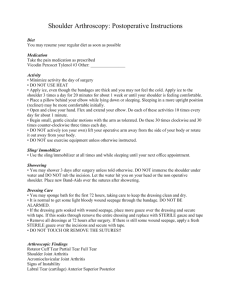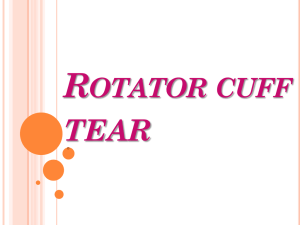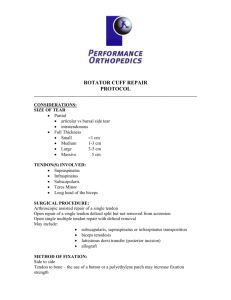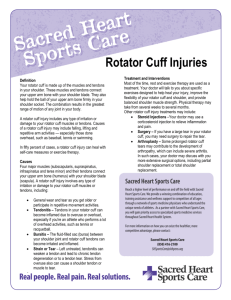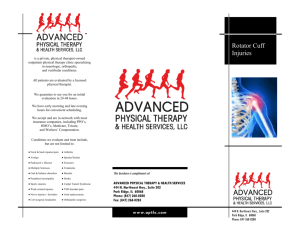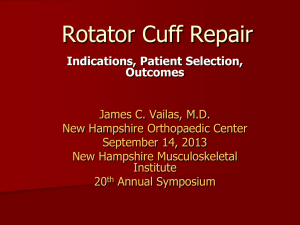Arthroscopic Rotator Cuff Repairs
advertisement
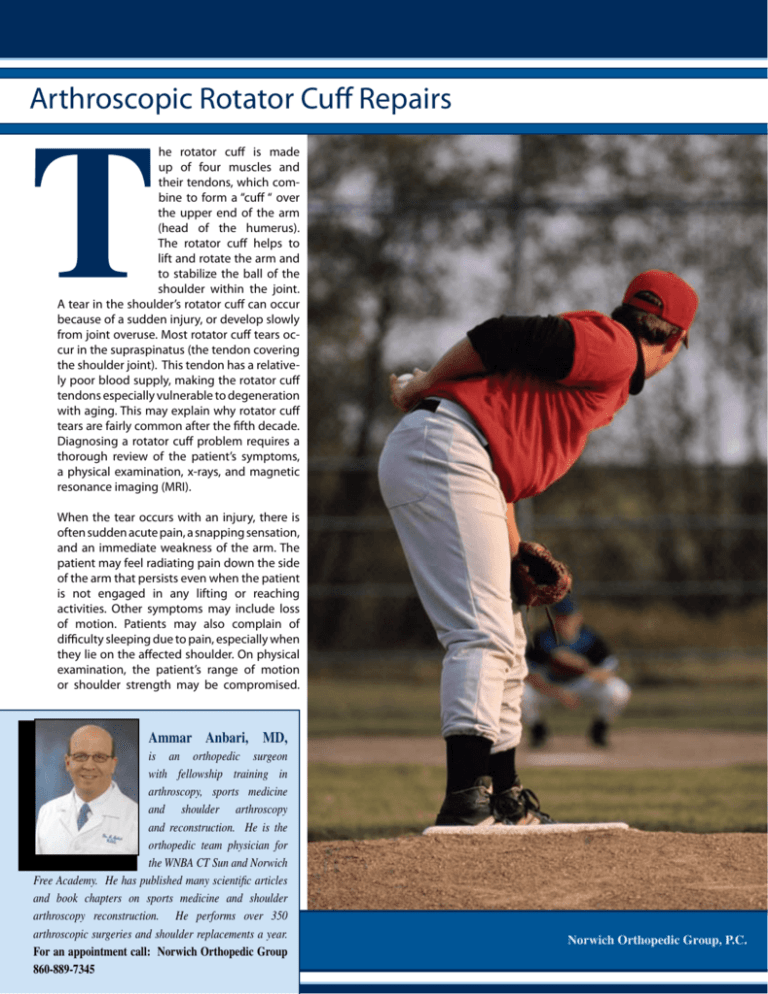
Arthroscopic Rotator Cuff Repairs he rotator cuff is made up of four muscles and their tendons, which combine to form a “cuff “ over the upper end of the arm (head of the humerus). The rotator cuff helps to lift and rotate the arm and to stabilize the ball of the shoulder within the joint. A tear in the shoulder’s rotator cuff can occur because of a sudden injury, or develop slowly from joint overuse. Most rotator cuff tears occur in the supraspinatus (the tendon covering the shoulder joint). This tendon has a relatively poor blood supply, making the rotator cuff tendons especially vulnerable to degeneration with aging. This may explain why rotator cuff tears are fairly common after the fifth decade. Diagnosing a rotator cuff problem requires a thorough review of the patient’s symptoms, a physical examination, x-rays, and magnetic resonance imaging (MRI). When the tear occurs with an injury, there is often sudden acute pain, a snapping sensation, and an immediate weakness of the arm. The patient may feel radiating pain down the side of the arm that persists even when the patient is not engaged in any lifting or reaching activities. Other symptoms may include loss of motion. Patients may also complain of difficulty sleeping due to pain, especially when they lie on the affected shoulder. On physical examination, the patient’s range of motion or shoulder strength may be compromised. Ammar Anbari, MD, is an orthopedic surgeon with fellowship training in arthroscopy, sports medicine and shoulder arthroscopy and reconstruction. He is the orthopedic team physician for the WNBA CT Sun and Norwich Free Academy. He has published many scientific articles and book chapters on sports medicine and shoulder arthroscopy reconstruction. He performs over 350 arthroscopic surgeries and shoulder replacements a year. For an appointment call: Norwich Orthopedic Group 860-889-7345 Norwich Orthopedic Group, P.C. ...results have been remarkably good showing faster recovery and pain reduction and ability to successfully repair atrophied and retracted tendons.” Other indications of a rotator cuff tear include atrophy of the muscles around the shoulder, and clicking upon shoulder movement. Before treating the tendon tear, radiographs are useful to reveal any evidence of arthritis, spurs within the shoulder, or loose bodies, The use of MRI can sometimes distinguish between a full-thickness tear of the tendon and a partial tear, whether the tear is within the tendon itself, or if the tendon is detached from bone. Unless there is evidence of a complete tear with minimal muscle atrophy or tendon retraction, initial treatment options may include rest, limited overhead activity, use of a sling, anti-inflammatory medications, steroid injections, strengthening exercises, and/or formal physical therapy. In the case of an acute or chronic tear that fails nonoperative management, arthroscopic surgery may be the best option. Arthroscopic Repairs Open repairs, done through incisions 2 inches or more in length, used to be the accepted method of treatment for many years. In the 1990’s, arthroscopic rotator cuff repair became the gold standard. The arthroscopic procedure is performed on an outpatient basis under general anesthesia. Patients are typically discharged within two hours of their operations. The technical aspects of this procedure have been substantially refined over the last five years. Four arthroscopic portals (approximately 1 cm in length) are made to allow for the insertion of a fiberoptic scope and small instruments. The scope is connected to a television monitor, and we perform the repair through manipulation of instruments and video observation. Retracted tears are mobilized by releasing soft tissue contractures arthroscopically. The tendon edge is repaired to the humerus with the use of resorbable bone anchors. Following placement of the anchors, the sutures within the anchors are passed through the rotator cuff, and using specialized knot-tying techniques, the tendon is attached back to the arm bone. Once we are assured of the integrity of the repair, the instruments are removed, and the arthroscopic portals are closed. Patients are placed in a sling for comfort, and an ice compression dressing is placed over the shoulder. Physical therapy to maintain and improve the range of shoulder motion begins immediately following surgery. The initial discomfort following the surgery gradually lessens over the first two weeks, when the sling is ultimately discarded. It takes about 12 weeks for the tendon to heal completely. Strengthening continues for four to six months, at which point patients are permitted to return to all activities in an unrestricted fashion. Recently, arthroscopic rotator cuff repair with double-row suture technique was introduced. This technique allows for more precise restoration of the rotator cuff attachment over a broad bony surface area. It uses two rows of anchors on the inner and outer edges of the www.norwichorthopedic.com tendon (figure 1). Personal clinical results have been remarkably good showing faster recovery and pain reduction and ability to successfully repair atrophied and retracted tendons. Recent laboratory and biomechanical studies have shown the following advantages of arthroscopic doublerow repairs over previous open and arthroscopic surgeries: ❯ Improved tendon footprint repair ❯ 60% greater contact between the bone and repaired tendon ❯ Increased load to failure ❯ Less gap formation between the bone and repaired tendon Figure 1



